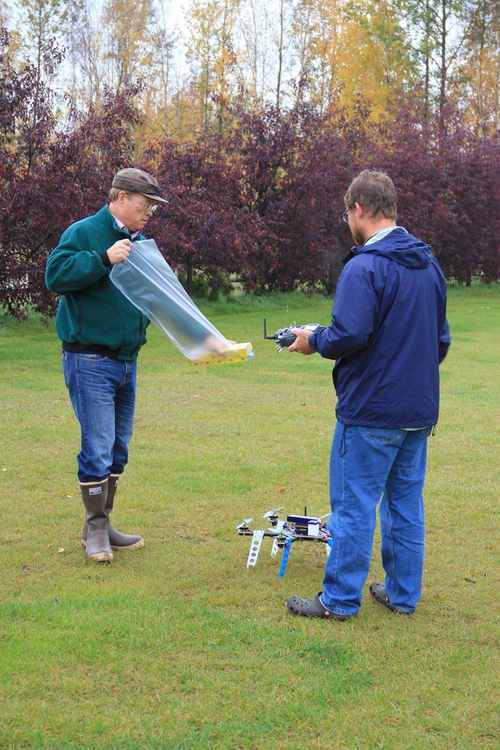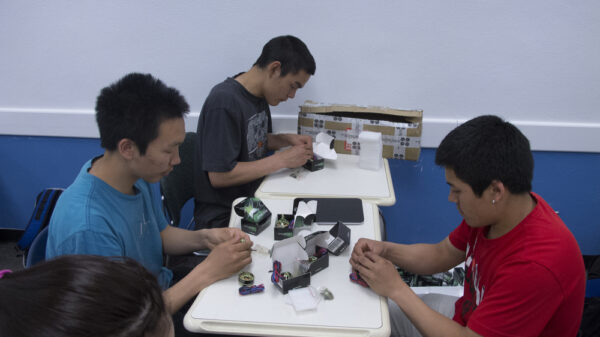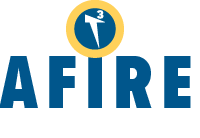The T3 Alliance evolved from Modern Blanket Toss: Engaging Underserved Students in STEM Fields through Unmanned Aerial Vehicles (MBT), a program at the University of Alaska Fairbanks (UAF) and funded through a grant from the National Science Foundation Experimental Program to Stimulate Competitive Research (EPSCoR) Track-3 grant from 2013-2016. NSF award #IIA-1348413
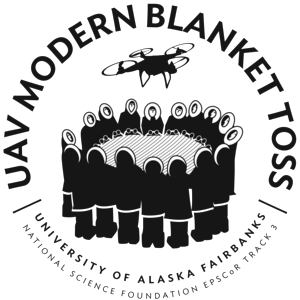
Dr. John Monahan, the director of the UAF Upward Bound program, was the Principal Investigator. Over the course of the three-year project, 60 low-income, prospective first-generation college students from five rural high schools took special elective classes during the Upward Bound summer program at the University of Alaska Fairbanks (UAF), in which they will learn UAV and GIS operation, science materials and methods, and science communication and leadership skills.
They returned to their home communities where, with academic-year Upward Bound support, they used UAVs as the basis for a local mapping project, which were selected and designed in conjunction with community leaders.
“We named this project after the Native tradition of the Blanket Toss, which enabled people to expand their horizons beyond their immediate surroundings. We want this project to do the same thing – literally, by giving students a bird’s eye view of their communities, and figuratively, by exciting them about college and STEM careers.”
– Dr. John Monahan
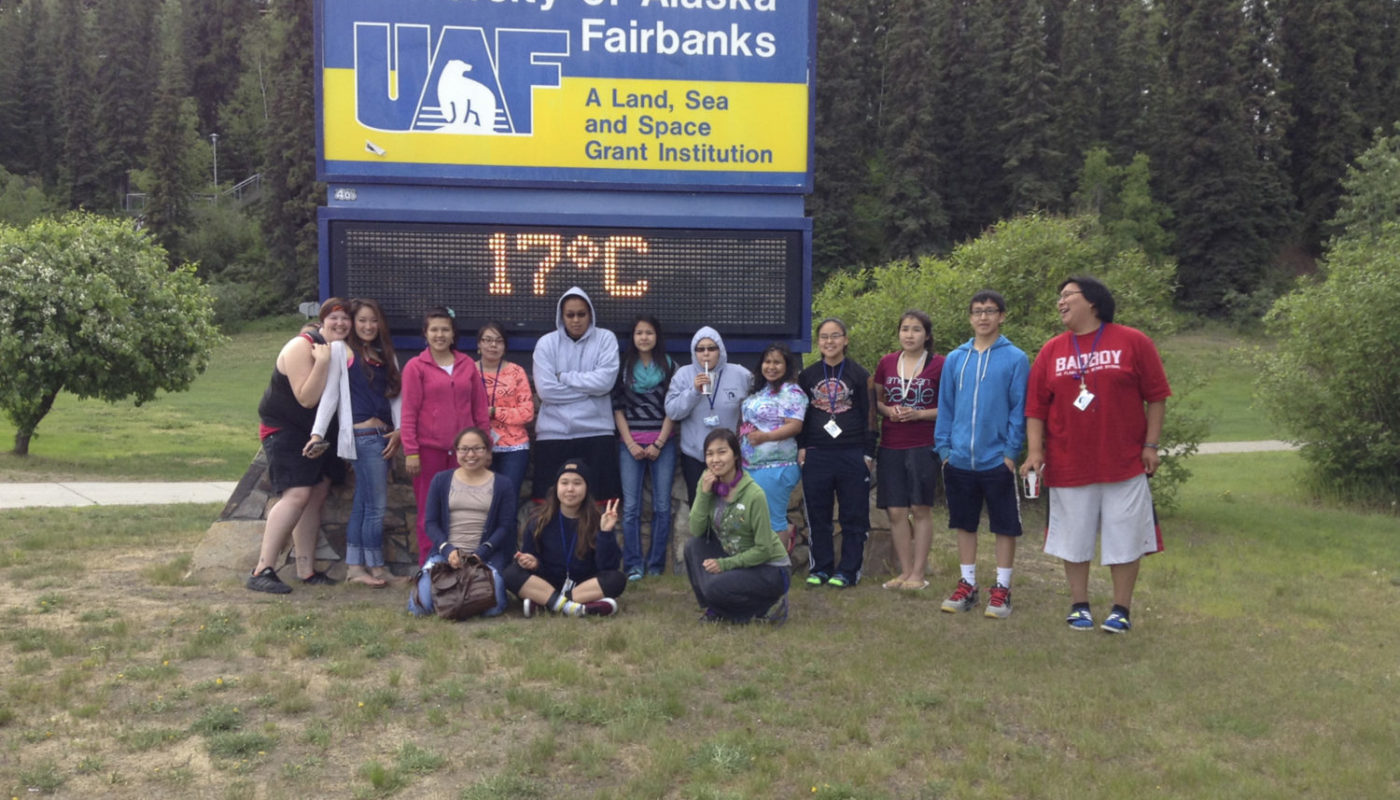
Background
MISSION
Help underserved students develop an interest in STEM fields through the use of technology that can directly improve the well-being of Alaskans.

High school students in rural Alaska face many roadblocks on the path to college and to science, technology, engineering, and math (STEM) careers. Many rural students come from low-income backgrounds and have never had family members attend college. Many live in impoverished communities inaccessible by road, and many are Alaska Natives, an underrepresented minority. Many also go to underachieving schools, making it difficult to interest them in STEM fields or college in general.
There were five communities tapped for this initial program – Bethel, Seward, Chefornak, Nikiski, and Shishmaref.
The five rural Alaskan communities selected for this project varied widely in terms of location, local economy, population size, poverty levels, racial makeup, and income. By choosing communities that represent a cross-section of rural Alaska, the leadership team was better able to make comparisons amongst project data and to evaluate how the program will transfer to alternate locations. Communities such as these present some of the most significant educational challenges in the United States.
Why UAVs?
UAVs are an ideal means with which to interest students in STEM, as they constitute an appealing and hands-on research tool which can be directly applied to productive, science-based problem-solving within the students’ home communities. They require students to understand the basics of physics, meteorology, and other fields, which were taught by Upward Bound instructors and through experts at UAF, an international leader in frontier UAV research.
Curriculum
The program was arranged into five interconnected components, which were instrumental in the program’s ability to reach its desired goals.
- UAV Flight School – UAV Flight school is modeled on a fixed-wing pilot’s license course that contains age and grade appropriate lessons, leading to a comprehensive UAV pilot’s license.
- UAV Hardware and Build – This component involves the hands-on element that teaches the skills and knowledge to build and fly a quadcopter.
- Software – A package of specialized STEM-oriented computer applications integrated into the project. It helps students relate to technology in multiple ways.
- Leadership Training and Communicating Science – An intensive course in which students focus on the complexities of working on a team, of managing the logistics of a project, and communicating with an audience at an appropriate level.
- Community Project – The students and site coordinators at each MBT local work together to identify an essential community-based project that could either be solved or illuminated through the use of a UAV.
Summer at UAF
As part of their summer Upward Bound coursework, students participating in the Modern Blanket Toss project took part in a specially-designed UAV Learning Module, incorporating construction and flight instruction of the UAVs, GIS, and Leadership. The module was delivered as an elective class for two hours a day for the duration of the six-week summer session.
In a broader sense, the curriculum was designed to teach students ways to “extend their senses” beyond visual capacity, to expand their situational awareness of interconnected systems, and to use a holistic ecosystem-based approach to problem-solving.
Under the direction of the UAF Upward Bound instructors and in collaboration with ACUASI (Alaska Center for Unmanned Aircraft Systems Integration), students learned basic science and math as well as specialized instruction that included:
- UAV Capabilities, Benefits, and Limitations,
- UAF and Aviation Safety
- Weather Knowledge
- Flight Physics
- Cartography
- UAV Payloads
- Mechanics and Electronics
- GIS Topics – Raster Methods and Tools, Shapefile, and GeoDatabase Editing
The classwork was paired with field trips to the Alaska Satellite Facility and GINA, both located at UAF, to learn more about remote sensing and mapping. Students also made more extended field trips to Poker Flat Research Range outside of Fairbanks, UAF’s UAV test site. Poker Flat has more than two dozen UAV’s, ranging from a 2.5 quad-rotor helicopter up to a 40-pound fixed wing.
Students gained experience with the specific type of quad-rotor UAV that was used throughout the program, and also took part in learning activities with other types of UAV’s, from balloons to fixed-wing aircraft. Students learned how to assemble, configure, calibrate and safely fly their UAV’s, and received instruction on flight modes, navigational tuning, mission planning and analysis, recording and playing back missions, and geotagging images. All students in the program learned all techniques necessary to pilot UAV’s and had multiple opportunities to do so, during the summer sessions and the academic year.
Building and Flying
One of the core (and most fun) activities of the UAV curriculum was building the UAV’s (otherwise known as “copters”), and learning how to fly them. Levels were developed for the building and flying areas of instruction to ensure a complete, accurate, and safe education surrounding the UAVs is delivered.
*include canva images detailing levels*
Community Projects
FROM KNOWLEDGE GAINED THROUGHOUT THE SIX-WEEK SUMMER PROGRAM, ALONG WITH A SPECIALIZED BRAINSTORMING SESSION DURING THE LEADERSHIP CLASSES- STUDENTS MAPPED OUT THEIR COMMUNITY PROJECTS.
Teacher Training

An important component of the UAV Flight School is that of training of the teachers, which entails familiarizing teachers with the basic structure of the curriculum and the licensing process. Ideally, teachers spend time practicing with the UAVs and learn to troubleshoot and identify potential difficulties for their students. The curriculum is organized in Gooru (an open-source online content delivery and assessment platform) and assessments are either paper-based or skill checklists.
During the Fall of 2015, a teacher training session was conducted where teachers were instructed in the use of the Gooru based UAV Flight School curriculum, leadership, and the advanced UAV and computerized control system. This two-day training was an intense session in which Upward Bound coordinators shared their observations, learned about the importance of Growth Mindset (have a side box about this), and most importantly how to operate and support students as they used the advanced UAV to work on their stated community projects (which had been brainstormed during the Upward Bound Summer Session)
What was Learned from MBT
Modern Blanket Toss has considerably informed the curriculum design for future grant initiatives. Four components make up a robust curriculum to both educate and empower youth on their way to becoming STEM professionals.
“First, we have a thorough online student curriculum focused on the proper use of technology. The knowledge transfer happens through online assessments and associated real-world, hands-on projects.
Second, we provide an appropriately designed technology kit for the lessons.
Third, to find compelling student projects, we provide a roadmap to teachers on how to engage STEM professionals as well as the broader community.
Fourth, to prepare and support teachers in their role as a guide to students, we provide a comprehensive teacher training program that includes online and face-to-face components.
Each of these elements is important and learned as part of MBT.
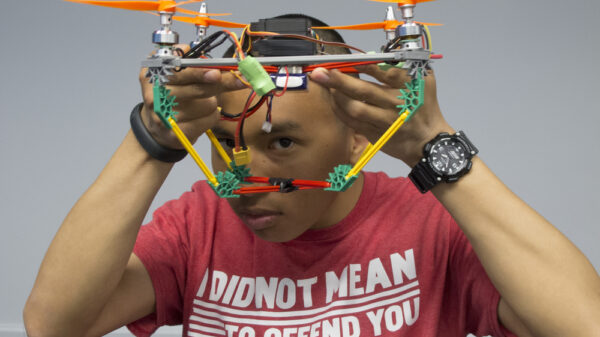
What Worked Really Well
Equipment
The K’NEX copters served their purpose for their designed mission, showing students how simple UAVs function, and then applying that knowledge to more complex UAVs. The Phantoms by DJI accomplished the goal of reliably collecting aerial footage and ease of flight for the students.
The Hexacopters worked well but could have been more efficient if the frame and parts could have purchased, and the UAV put together in a clearly established fashion. As it was, we learned about interference by placing the compass too close to the battery. A valid lesson, but not when it leads to a costly crash.
Training
The most effective method for motivating students to work collaboratively using the GIS technology and UAVs was in orchestrating a service learning project for them to participate in that was attainable. If the representative organization was engaged in connecting with the students about the underlying issue, students were very motivated to employ the technology and present meaningful data. When the students received recognition for their work, they usually beamed with pride and spoke highly of the experience.
What We need to Address in Future Teacher Training
Many components are essential to a successful teacher training:
A segment on how to create a Growth Mindset environment when everyone is doing something different. This unit can involve brain research, testimonials from successful STEM professionals, ultimately setting the tone for how STEM learning occurs.
Course and program administration in online and real-world synchronous environments. Instruction includes how to monitor student progress, utilize rubrics, and create meaningful ceremonies to celebrate achievements.
Explanation and demonstration of items provided in the technology kits. There is an assumption that students may surpass the teacher in knowledge and skill level of the various technology tools. However, the teacher should focus on and be concerned about how to assess student proficiency, accessing outside expert help when needed.
Culminate in a unit on how to present and search for community projects by having organized STEM community resources.
BOOKS OF MBT
Click on any of the E-books below and enjoy the story of the modern BLANKET TOSS PROJECT in its entirety.
